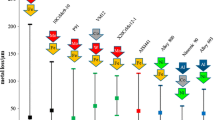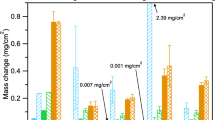Abstract
The influence of the electrode potential on the corrosion behavior of a series of nickel- and cobalt-base gas turbine alloys has been investigated in a (mole %) 53Na2SO4+7CaSO4+40MgSO4 melt at 1073 and 1173 K and in a 90Na2SO4+10K2SO4 melt at 1173 K. Only acidic fluxing is observed in the (Na 2,Ca, Mg)SO4 melt at positive potentials while a protective scale rich in MgO is formed on all alloys at negative potentials. This scale prevents basic fluxing because MgO is insoluble in neutral and basic melts. The breakthrough potential for acidic fluxing is a function of the material composition. Increasing chromium content of the alloys extends the potential range of protective film formation. Acidic and basic fluxing are observed in the (Na, K)2SO4 melt. Acidic fluxing occurs at positive and basic fluxing at negative potentials. A protective scale is formed in an intermediate (neutral) potential range on the high-chromium alloys IN-597 and IN-738 LC. Here, too, the breakthrough potentials for acidic and basic fluxing are influenced by the composition of the alloys.
Similar content being viewed by others
References
W. T. Reid,External Corrosion and Deposits, Boilers and Gas Turbines (Elsevier, New York, 1971).
A. B. Hart and A. J. B. Cutler,Deposition and Corrosion in Gas Turbines (Applied Science Publishers, London, 1973).
R. W. Bryers,Ash Deposits and Corrosion Due to Impurities in Combustion Gases (Hemisphere, Washington, D.C., 1978).
D. Coutsouradis, P. Felix, H. Fischmeister, L. Habraken, Y. Lindblom, and M. O. Speidel,High Temperature Alloys for Gas Turbines (Applied Science Publishers, London, 1978).
A. Rahmel, inMolten Salt Technology, D. G. Lovering, ed. (Plenum, New York, 1982) p. 265.
A. Rahmel and E. Tatar-Moisescu,Werkst. Korros. 26, 513 (1975).
U. Jäkel and W. Schwenk,Werkst. Korros. 26, 521 (1975).
A, Rahmel, inAsh Deposits and Corrosion Due to Impurities in Combustion Gases (Hemisphere, Washington, D.C., 1978), p. 185.
A. Rahmel,Werkst. Korros. 28, 299 (1977).
N. S. Bornstein and M. A. DeCrescente,Trans. AIME,245, 1947 (1968).
J. A. Goebel and F. S. Pettit,Metall. Trans,1, 1943, 3421 (1970).
W. P. Stroud and R. A. Rapp inHigh Temperature Metal Halide Chemistry, D. H. Hildenbrand and D. D. Cubicciotti, eds. (The Electrochemical Society, Princeton, 1978), p. 574.
D. K. Gupta and R. A. Rapp,J. Electrochem. Soc. 127, 2194 (1980).
A. Rahmel,Electrochim. Acta,21, 853 (1976).
E. Tatar-Moisescu and A. Rahmel,Electrochim. Acta 20, 479 (1975).
A. Rahmel,Werkst. Korros. 19, 750 (1968).
R. A. Rapp and K. S. Goto, in2nd International Symposium on Molten Salts, A. Braunstein and F. Selman, eds. (The Electrochemical Society, Princeton, N.J., 1982).
A. Rahmel,Electrochim. Acta,15, 1267 (1970).
A. Rahmel, M. Schmidt, and W. T. Wu,Electrochim. Acta to be published.
H.-E. Bühler and H. P. Hougardy, “Atlas of Interference Layer Metallography”, Deutsche Gesellschaft für Metallkunde, Oberursel 1980 (available also at The American Society of Metals and the Metals Society).
E. Erdös, inDeposition and Corrosion in Gas Turbines (Applied Science Publishers, London, 1973), p. 115.
W. T. Wu, I. Aydin and H.-E. Bühler,Prakt. Metallogr. 19, 322 (1982).
A. Rahmel, M. Schorr, and W. T. Wu, to be published.
J. W. Born and C. H. MacGillavry,Rec. Trav. Chim. Pays Bos,61, 910 (1942).
W. Rüdorff and K. Stegemann,Z. Anorg. Allg. Chem. 251, 376 (1943).
P. F. Bongers, C. F. van Bruggen, J. Koopstra, W. P. F. A. M. Ornloo, G. A. Wiegers, and F. Jellinek,J. Phys. Chem. Solids,29, 977 (1968).
E. Erdös, A. Rahmel, M. Schorr, and W. T. Wu,Oxid. Met. to be published.
J. Stringer inProceeding of the Symposium on Properties of High Temperature Alloys, Z. A. Foroulis and F. S. Pettit, eds. (The Electrochemical Society, New York, 1976), p. 513.
W. T. Wu and A. Rahmel, to be published.
A. Rahmel,Electrochim. Acta,13, 495 (1968).
Author information
Authors and Affiliations
Rights and permissions
About this article
Cite this article
Rahmel, A., Schmidt, M. & Schorr, M. The influence of electrode potential on the corrosion of gas turbine alloys in sulfate melts. Oxid Met 18, 195–223 (1982). https://doi.org/10.1007/BF00662038
Received:
Revised:
Issue Date:
DOI: https://doi.org/10.1007/BF00662038




